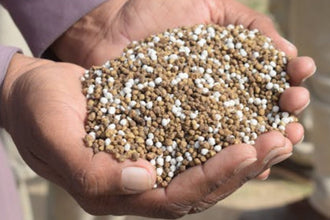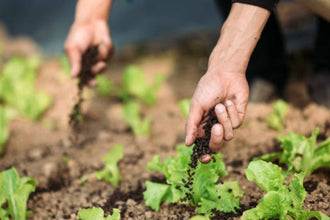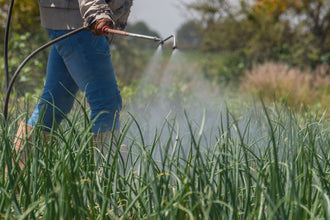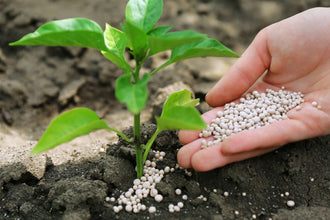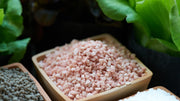
A balanced fertilizer gives your plants all three main nutrients they need in the right amounts. You've probably seen those three numbers on fertilizer bags like 10-10-10 or 4-2.5-2. These numbers tell you how much nitrogen, phosphorus, and potassium you're getting.
Most gardeners struggle with the same thing. They want healthy plants but don't know which fertilizer to use or when to use it. Balanced fertilizer takes the guesswork out of feeding your garden. It works for almost everything you grow and keeps your soil healthy year after year.
The best part? You don't need to be a soil scientist to get great results. Once you understand the basics, using balanced fertilizer becomes second nature.
What Makes a Fertilizer Balanced
Balanced fertilizer gives your plants nitrogen, phosphorus, and potassium in amounts that work well together. Think of it like a complete meal for your plants instead of just a snack.
Each nutrient does something different for your plants. Nitrogen makes leaves green and helps plants grow fast. Phosphorus builds strong roots and helps flowers bloom. Potassium makes plants tough so they can handle stress better.
You can find balanced fertilizer in different ratios depending on what your plants need. Some have equal amounts of all three nutrients. Others have a bit more of one nutrient than the others.
Understanding NPK Ratios
Those three numbers on fertilizer bags show you exactly what you're getting. The first number is nitrogen, the second is phosphorus, and the third is potassium. A 10-10-10 fertilizer has equal amounts of all three. A 4-2.5-2 fertilizer has more nitrogen than the other two.
Different plants like different ratios:
• Leafy greens like lettuce and spinach want more nitrogen • Flowering plants need extra phosphorus when they bloom • Root vegetables like carrots need good potassium levels
You don't need to memorize all this stuff. Most balanced fertilizers work fine for general garden use. Save the specialty ratios for when you notice specific problems with your plants.
Slow-Release vs Quick-Release Options
Quick-release fertilizers work fast but don't last long. They're like giving your plants an energy drink. The nutrients dissolve right away and plants can use them immediately. You'll need to apply them more often, usually every few weeks.
Slow-release fertilizers work differently. They break down slowly over months, feeding your plants little bits at a time. This prevents burning your plants and means less work for you. Most organic balanced fertilizers work this way.
Which one should you use? Slow-release works better for most situations. It's harder to mess up and gives you better long-term results. Save quick-release fertilizers for fixing problems fast or feeding container plants that need frequent nutrition.
When to Apply Balanced Fertilizer
Timing matters more than most people think. Apply fertilizer when your plants can actually use it, not just when you remember to do it. Plants need different amounts of nutrition throughout the year.
Spring is usually the best time for your first application. Wait until the soil warms up and your plants start growing again. This gives them fuel for their biggest growth period.
You might need a second application in early summer if you're growing heavy feeders like vegetables. Don't fertilize too late in the season or you'll encourage tender new growth that frost can damage.
Seasonal Timing Guidelines
Different types of plants need fertilizer at different times. Cool-season crops like peas and lettuce grow best in spring and fall. Feed them when they're actively growing, not during hot summer months when they're struggling.
Warm-season vegetables like tomatoes and peppers need their first feeding after the soil stays warm consistently. Usually this means late spring or early summer in most areas.
Here's when to fertilize common garden plants:
• Spring vegetables: Feed when you plant them and again 4-6 weeks later • Summer vegetables: First feeding in late spring, second in early summer • Perennial flowers: Once in early spring as new growth starts • Trees and shrubs: Early spring for established plants, throughout first growing season for new plantings
Plant-Specific Applications
Container plants are different from garden plants. They need more frequent feeding because water washes nutrients out of pots quickly. Feed container plants every 2-3 weeks during growing season with diluted balanced fertilizer.
New plants need gentle feeding while they establish roots. Don't go crazy with fertilizer on newly planted trees or shrubs. A light application of balanced fertilizer helps them settle in without overwhelming their developing root systems.
Your lawn is basically one giant plant that needs regular feeding. Spring and fall applications work best for most grass types. Spring feeding helps grass green up after winter. Fall feeding helps it store energy for winter survival.

How to Apply Balanced Fertilizer Correctly
Getting application right makes all the difference between healthy plants and wasted money. The method depends on what type of fertilizer you're using and where you're applying it.
Granular fertilizers need to be spread evenly across the soil. You can use a spreader for big areas or just scatter it by hand for smaller gardens. Always water after applying granular fertilizer to dissolve the pellets and get nutrients moving into the soil.
Liquid fertilizers give you more control over where the nutrients go. Mix them according to directions and apply directly to soil, not plant leaves. Early morning works best for liquid applications.
Soil Preparation and Testing
Test your soil before you start throwing fertilizer around. You might already have plenty of some nutrients and need more of others. Basic soil tests aren't expensive and they tell you what your soil actually needs.
When you're preparing new beds, work fertilizer into the top few inches of soil. Most plant roots stay near the surface anyway, so that's where nutrients need to be. Don't bury fertilizer too deep where roots can't reach it.
Adding compost or other organic matter along with balanced fertilizer gives you better results. The organic matter helps soil hold onto nutrients longer instead of washing away with the first heavy rain.
Application Rates and Frequency
Follow the directions on your fertilizer package, but use some common sense too. Sandy soil drains fast so nutrients wash away quickly. You might need lighter, more frequent applications. Heavy clay soil holds nutrients longer but doesn't need feeding as often.
Keep track of when you fertilize and how your plants respond. Some plants might need more or less than others. This helps you figure out what works best in your specific garden.
Split your applications instead of dumping everything at once. Two or three smaller applications throughout the growing season work better than one big dose. Plants can only use so much fertilizer at once anyway.
Avoiding Common Balanced Fertilizer Mistakes
Even experienced gardeners mess up fertilizer applications sometimes. Learning from common mistakes saves you time, money, and dead plants.
The biggest mistake is using too much fertilizer. More isn't better when it comes to plant nutrition. Too much nitrogen makes plants grow too fast with weak, floppy stems that attract bugs and diseases. Excess phosphorus can actually prevent plants from absorbing iron, making leaves turn yellow even though you just fertilized them.
Never apply fertilizer to dry soil. This concentrates the nutrients and can burn plant roots. Water your plants first, or time your applications before expected rain. Moist soil dilutes the fertilizer and makes it safer for roots.
Timing and Weather Considerations
Don't fertilize right before heavy storms that will wash everything away before plants can use it. Light rain after fertilizing is perfect. It helps move nutrients into the soil without causing runoff.
Hot weather increases the risk of fertilizer burn, especially with quick-release products. Apply fertilizer during cooler parts of the day and water well afterward. Morning applications work much better than afternoon or evening timing.
Wind affects how evenly you can spread granular fertilizer. Choose calm days for spreading, or switch to liquid applications when it's too windy for even coverage.
Plant Health and Stress Factors
Stressed plants can't use fertilizer effectively. Fix water problems, pest issues, or diseases before you fertilize. Healthy plants respond much better to nutrition than plants that are already struggling with other problems.
Don't fertilize dormant plants. They're not growing so they can't use the nutrients anyway. Save your fertilizer for when plants are actively growing and can actually benefit from the extra nutrition.
Building Long-Term Soil Health with Balanced Fertilizers
Good gardening isn't just about this year's plants. Building healthy soil that supports plants naturally takes time, but it's worth the effort. Balanced fertilizer plays a big part in this process when you use it right.
Organic balanced fertilizers do more than just feed plants. They feed the beneficial bacteria and fungi living in your soil too. These tiny organisms help break down organic matter, cycle nutrients, and protect plant roots from diseases.
Combine balanced fertilizer with regular additions of compost, mulch, or other organic matter. This creates living soil that gets better every year instead of just getting by on artificial life support.
Supporting Soil Biology
Healthy soil is alive with millions of beneficial organisms. Chemical fertilizers give plants quick nutrition but don't feed these helpful microbes. Organic balanced fertilizers contain carbon compounds that soil organisms need to thrive.
These beneficial microbes then release nutrients slowly as plants need them. It's like having a natural time-release system built into your soil.
Avoid disrupting soil biology with harsh chemicals or too much digging. No-till methods preserve soil structure and protect the organisms that make soil healthy. This approach works especially well with slow-release balanced fertilizers.
Creating Sustainable Growing Systems
Rotate your crops to prevent depleting specific nutrients and reduce pest problems. Different plant families use nutrients in different proportions. Follow heavy feeders like corn with light feeders like beans to balance things naturally.
Pay attention to what your plants are telling you instead of just following calendar dates. Plants show you what they need through their growth patterns and leaf color. Learning to read these signs helps you apply fertilizer when it will do the most good.
Build up your soil's organic matter levels to reduce fertilizer dependency. Soil with lots of organic matter holds nutrients better and releases them gradually. This natural system reduces how much fertilizer you need while producing healthier plants.
Get Started with Better Plant Nutrition Today
Balanced fertilizers take the mystery out of feeding your plants while building better soil for the future. Success comes from understanding what your plants need and timing your applications right.
Start by testing your soil to see what you're working with. Choose a balanced fertilizer ratio that matches your plants and growing conditions. Apply it when your plants can use it most effectively, and always water well afterward.
Your garden will reward you with stronger plants, better harvests, and fewer problems throughout the growing season. Balanced fertilizer gives you the foundation for gardening success, whether you're growing food, flowers, or just trying to keep your lawn looking good. Take the first step toward healthier plants by picking the right balanced fertilizer for your garden's needs.




